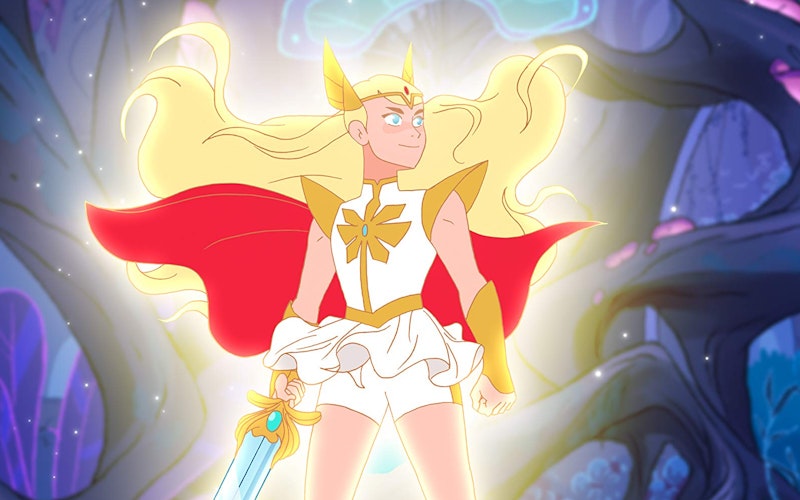
TV
She-Ra and the Power of Community
Netflix’s She-Ra reboot, helmed by comics writer and artist Noelle Stevenson, signals its shift from the 1980s original with its title. She-Ra and the Princesses of Power (as opposed to She-Ra: Princess of Power) is a subtly more inclusive version of the fun, brightly colored fantasy adventure. And as such, it reflects a Christian sense of what it means to find identity not within yourself, but within community.
She-Ra takes place in the fantastical land of Etheria, where Adora (voiced by Aimee Carrero) is a captain in a conquering army known as The Horde, led by the lizard-like Hordak (Keston John). Taken in as an orphan and raised to be a super-soldier, Adora fights alongside the Horde in a battle against the kingdom of Brightmoon. While on a mission, she discovers a magical sword that reveals her true identity: the incarnation of the legendary warrior She-Ra, sworn protector of all the kingdoms of Etheria. Now, Adora must come to terms with the deception of Hordak and fulfill her new purpose: to bring the leaders of Etheria together to defeat him.
In his essay “Moving from Solitude to Community to Ministry,” Henri Nouwen writes that the path to effective Christian community begins with recognizing your own identity as a beloved child of God. This applies to Adora’s journey as well. Before she can take on her destiny as She-Ra, she must first reconcile with the radical change in identity that her new role brings her. Adora recognizes the Horde’s destructive impact on the peace-loving people of Etheria and seeks forgiveness for her part in that. She rejects her previous life, defined by fierce competition and distrust, and embraces one defined by love and acceptance, evidenced in her newfound friendships with resistance leaders Glimmer (Karen Fukuhara) and Bow (Marcus Scribner).
The show’s aesthetic sense reflects the stark difference between the worldview of Etheria—one based on love and community—and the worldview of the Horde, which is based on dominance and competition. The Horde’s base of operations, the Fright Zone, is given a dark, limited color palette. Characters wear similarly colored uniforms and reside in mechanical, metallic settings. It’s a significant contrast to Etheria’s bright pastel hues and diverse realms, which suggest a society where each member is prized for how their individual strengths contribute to the collective whole, rather than a strict hierarchy where everyone competes to be at the top of the pile.
That difference in philosophy proves to be the breaking point in the relationship between Adora and her former best friend, Catra (AJ Michalka). Adora and Catra both suffered abusive childhoods as wards of the Horde and were each other’s sole allies. Adora asks Catra to come with her when she switches sides, but Catra refuses, seeing Adora’s new identity as a betrayal. Catra uses their estrangement to prove her worth as a soldier to Hordak.
Christian community begins with recognizing your own identity as a beloved child of God.
In his essay, Nouwen notes that during the search for our place among a community of believers, there’s always tension, a desire to prove ourselves. Often we seek validation from others. He reminds us this desire was what the devil used to tempt Jesus in the wilderness by asking him to exercise his strength and divine power. It’s also what causes the disciples to argue over their roles. But if we wish to weather disappointment or failure, we must reject the worldly ambition to demonstrate our own power or success. We have nothing to prove, because we’re already beloved by God. As believers, we are already assured in our identity and can use that knowledge to build community with others who are assured in theirs.
As Catra seeks validation in battle, her failures become a growing source of frustration and irreparably damage her relationship with Adora. This eventually leads to a climactic showdown where the pair, caught in an illusion simulator, are confronted with memories of their shared past. Throughout, the color scheme shifts between that of the abandoned Etherian citadel they’re stuck in and the Fright Zone. For Adora, the experience represents a pull between her cherished memories with Catra and the future she’s pursuing. To fully embrace her new life, Adora must realize that her understanding of her relationship with Catra, and Catra’s understanding of it, have never been on the same plane. Adora must let go of the toxic relationship that’s been holding her back, even if it’s painful to do.
As Adora builds new relationships with Glimmer and Bow and creates community among the princesses of Etheria, they gain the other princess’ trust by empowering them in distinct ways. Passive Princess Perfuma learns how to fight her own battles. Sarcastic Princess Mermista learns to trust outsiders. As Adora’s alliances grow, each member of the group becomes assured of their own identity and ability. They’re moving from solitude—each trying to defend their own lands individually—to community, learning to work together for the good of all. As Nouwen writes, “When you are aware that you are the beloved, and when you have friends around you with whom you live in community, you can do anything. You’re not afraid anymore… You’re free.”
The picture of community, identity, and mission given in She-Ra and the Princesses of Power allows for grace and inclusion among its characters. There are warrior princesses, but also a nerd princess, a plant princess, a child princess, and male characters who aren’t rulers at all, but are content being allies. Everyone is different. Everyone has flaws. But everyone also has something important to bring to the table. And everyone is cared for by the other members. It’s a vision that enriches the show’s story and encourages virtues of patience and openness among its young target audience. It’s also a suggestion of what a strong community defined by faith and rooted in divine love might look like.
Topics: TV